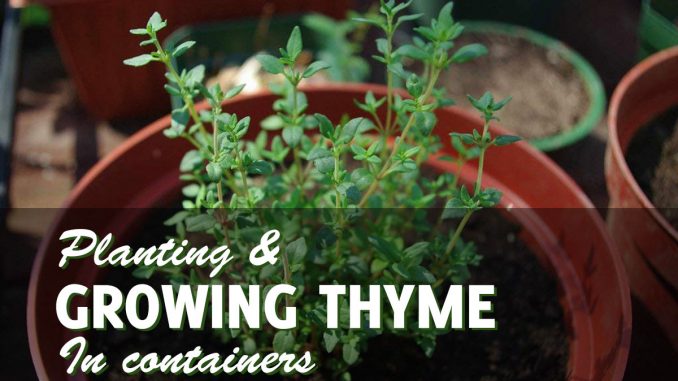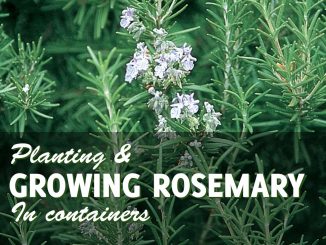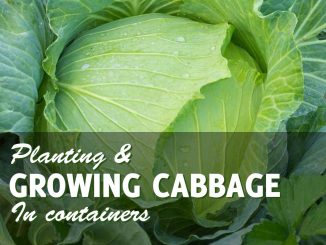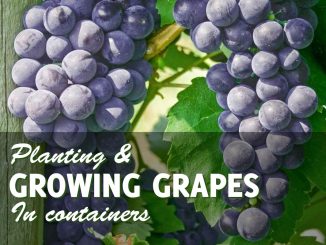
Growing thyme in pots is simple and rewarding; this versatile herb that can be used to flavor tomato-based sauces, slow-cooked beef, stuffing, fish, and steak. Those who do not like to cook can still benefit from the fragrance of thyme as it can be used as an ornamental edging in a garden.
Although it grows well on garden grounds, it can still be very easy to grow thyme in pots. If you wish to grow thyme as an ornamental, golden and variegated varieties will do well. For those who love to cook, common garden thyme is the most suitable for container gardening.
Before You Start Growing Thyme in Pots
Prepare an area that has at least 8 hours of direct sunlight for growing thyme in pots. Your chosen area must not be damp and has adequate air circulation but sheltered from strong winds. Although thyme loves the sun as any herb, it does not do well in hot, arid conditions. High temperatures will result in a woody plant that has no flavor. If you live in such an area, you might want to place your plant so that it will have the best of the morning sun and the protection of the afternoon shade. You can also place your thyme by a bright, sunny window if you wish to grow thyme indoors.
Picking the Right Pot to Grow Thyme
You need a container that is at least 8 inches deep when growing thyme in pot. It would be best to choose a terracotta pot, especially if you live in a cool environment. Terracotta pots will help insulate the roots during winter, and it also helps absorb moisture from the soil. Make sure that you have drainage holes placed at the bottom to prevent drowning your thyme. To further help in draining excess water, layer small pea pebbles or pieces of broken terra cotta pots at the bottom.
Preparing Potting Mix to Grow Thyme
Do not use ordinary garden soil for growing thyme in pots. Buy a potting soil in local garden stores and amend it with a cup of sand to further aid in drainage of water. Thyme prefers a potting mix that is light, sandy, and low in nutrients. Adjust the potting mix to a pH of 6.0-8.0 to help keep healthy roots. There is no need to prepare the soil with fertilizer. Your potting mix already has a dose of compost necessary for the first few months of initial growth.
Thyme Seeds for Growing in Pots
You can start easily from seeds when growing thyme in containers, but be prepared for a full year of waiting before you can have the pleasure of admiring its aroma and flavor. You can purchase seeds at a local garden center, however, I would recommend looking online for a good heirloom variety.
March will be the perfect time to sow your thyme seeds. Prepare a seedling tray or a pot that is 2-3 inches in size and fill it with potting compost. Place seeds on your growing medium and cover it with 1/4 inch compost. Water the container well using a fine mist to prevent disturbing the seeds.
Germination usually begins 7-10 days as long as you keep the seedling trays warm and moist. It can be done indoors under a fluorescent or led grow light with your seedling trays covered with either glass or clear plastic. If condensation disappears, mist the seedling trays to keep the potting medium moist. Once the seedlings emerge, trim out the rest and keep 2-3 seedlings. Your thyme will be ready for transplant once they are 4-5 inches tall, but you must harden them for a week or two before you place them outside. Harden by placing them outdoors during the day under the shade, then bringing them inside once the sun goes down.
Growing Thyme in Pots From Root Divisions
Although you can start growing thyme in pots using cuttings, it is not advisable as the success rate is quite low. Root divisions can be an alternative, which you can get from a good friend or neighbor that has thyme that is 3-4 years old. Make sure that your root division has a good amount of roots and foliage. Dig a hole at the center that is twice the size of your root ball. Place the root division at the center and carefully cover with soil, tamping once you get to the top to make sure that air pockets are removed and the soil level is even all throughout the pot. Water well and place in a sunny location.
Care and Harvest of Thyme Grow in Pots
Be sure to give your plant adequate water when growing thyme in pots by giving it heavy watering when the soil is dry 2-3 knuckles down. Some people have problems with thyme if the soil is continually moist. Give your thyme liquid plant food such as fish or seaweed emulsion every two weeks only from April to August. Too many nutrients will result in a plant that is “leggy” and has no flavor. Protect your thyme by mulching with leaf mulch or homemade compost during autumn to help insulate the roots and protect your herb from frost.
Thyme becomes very woody after three years, which makes it necessary to divide and re-plant your herb. Harvesting can be done after a year if you started from seeds, which can be done by snipping off branches of thyme as you need them. Although you can harvest throughout the entire year, thyme will give you the best flavor during the middle months of June and July. Decrease the rate of harvest during the winter months.
You have the option of freezing or drying your thyme so you can still have an abundance of flavor even during the slow growing season.
Thyme is a very hardy plant and experiences only a few pest and disease problems. Prevent powdery mildew by watering only directly on the soil to keep the leaves dry when growing thyme in pots.
If you are looking for other easy to grow herb for your garden, check out our guide on growing sage in pots!




Be the first to comment